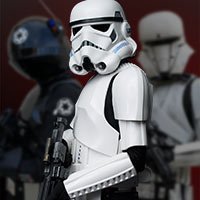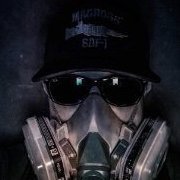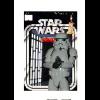Search the Community
Showing results for 'Isopropyl alcohol'.
-
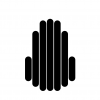
Chopper857's ANH TK Stunt build
themaninthesuitcase replied to Chopper857's topic in Build Threads Requireing Maintenance
RS should work well with the Anovos helmet, there are many who believe they are both based on the same original armour. Looking at my Anovos helmet it does seem your gap between the face plate and cap is a bit larger how ever I've had mine apart so could be how I put mine back together. For the frown I used Humbrol Enamel thinners and possibly some Isopropyl alcohol. The thinners can be got at Hobbycraft (get a big 125ml one it evaporates FAST) and the IPA at a chemist, independents are more likely to have it vs a boots etc. I just cleaned off all the grey and then repainted with Humbrol Enamel #5 Admiralty grey. On mine I pulled out all the standard internal stuff as it's a bit pants. For the lens I measured out and drilled the lens it's self to fit the screws that hold the ears on. These screws should ideally be swapped out for some M3.5 counter sinks painted white (again i used Humbrol, white gloss). screws:http://www.spaldingfasteners.co.uk/metric-brass-countersunk-slotted-head-machine-screws-m3-m4-m6/I used the M3.5x 30mm long nuts: http://www.spaldingfasteners.co.uk/metric-coarse-brass-hexagon-full-nuts-m2-m3-m3-5-m4-m5-m6-m8-m10/ washers : http://www.spaldingfasteners.co.uk/metric-brass-flat-washers-m3-to-m10/ This shows my lens mounting. For the padding I used some cheap tactical pads from eBay but a foam clover is also popular and was what was used on the set. The clover is just some 1" foam cut to a shape that works well in the bucket. I wouldn't worry about plastidip. You'll find very few people bother in the UK and people I've spoken to who've done it here say it wasn't worth it. The one other thing people will usually do on the Anovos helmet is either change the mesh or the whole mic tip (aka hovi tip). The mesh on the anovos is too fine, I swapped mine out for a bit cut from a poundland sieve but I'm still not 100% happy so might change them for some others in future. My bucket refurb starts on this page and is a bit scattered amongst the armour build: http://www.whitearmor.net/forum/topic/35424-themaninthesuitcase-anovos-ahn-stunt-build/page-5 -

Salvaging my backup ATA helmet
zemzero replied to Comfy Turtle's topic in Build Threads Requireing Maintenance
Not sure what you're asking in your first question, are you looking for the nut that fits the bolt? If so, just take the bolt out, take it to a hardware store and match it up to the right nut size. Sandpaper will get rid of the decal completely but be prepared for a lot of sanding to bring the surface back to a polished finished. I'm hesitant to give this advice because of how disastrous the outcome could be but acetone dissolves CA glue. However, acetone will also eat the plastic of your helmet so you would have to be extremely careful if you go that route. Just do little by little with a cloth, rubbing the glue off the helmet. Depending on the type of paint you used, you can easily get rid of it to start again. Mineral spirits will take away enamel paint and isopropyl alcohol will take off acrylic. Usually. The nail polish...did you use nail polish or nail polish remover? Either way, I see nothing that can't be fixed. -

What do I use to Clean / Shine PVC Armor?
aliens8us replied to Arsnik's topic in Hard Armor (General Discussion)
I tend to use Mr. Clean's 'Magic Eraser' for smears and scuffs. For cleanup with paint and dirt, I use isopropyl alcohol 70%. Novus is good to use for that extra 'Emperor inspection' shine! Sent from my iPhone using Tapatalk -

ANOVOS TK (discussion forum)
themaninthesuitcase replied to ukswrath's topic in ANH (Stunt and Hero)
Id say they are too small and would possibly pull through. I used M4 pan head screws on my TD. I used Humbrol thinners for the frown, tube stripes and traps/tears. Isopropyl alcohol on the vocoder and then more thinners to clean up. -
I wonder if it needed a longer cure time or something. I left it for 24 hours before putting the gloves on. I also cleaned the backs with isopropyl alcohol and sanded them down with 100 grit sandpaper prior to putting on the glue.
-

themaninthesuitcase Anovos ANH Stunt Build
themaninthesuitcase replied to themaninthesuitcase's topic in ANH Build Threads
Mine came from here: http://www.spaldingfasteners.co.uk/ I got a bag of 10 along with washers and metric (course) nuts. Wasn't very expensive, £3.06. The humbrol enable thinners (not acrylic) made short work of the transfers. It works on the frown but was harder work and used a fair bit. The vocoder was Isopropyl Alcohol to get most of it off then the thinners to clean up. Get the 125ml thinners as it evaporates fast and you need a fair bit. I think I've lost about 1/5 of the 28ml to evaporation but this is probably down to the small jar size. -

themaninthesuitcase Anovos ANH Stunt Build
themaninthesuitcase replied to themaninthesuitcase's topic in ANH Build Threads
Delivery from Hornby! For reference Hornby will charge you £5 for delivery then not actually bother to dispatch for a week... After fixing the shoulder bell I promptly broke it again the following morning testing the fix. So I did it again. Bit heavier on the outside this time. This will need to be sanded but as it's the under side I'm hoping it won't be too visible. I also embedded a small strip of offcuts scrap into some paste on the back to help reinforce the break as I will possibly need to heat bend the bell out a bit. The other night I glued the plate onto the TD thus completing the first whole part on this build. Huzzah. It still needs the white plastics polishing though. The evening I glued up the TD I started dissasembling the bucket to clean up the paint. I spent some time filing out some of the eyes to get them closer to a reference image: http://img.photobucket.com/albums/v336/themaninthesuitcase/TK%20Reference/DaveM3_zpsww1ihblr.jpg I probably could go farther but the reference image has a small return edge there and I was worried about messing up. I also tested the M3.5 screws for size and they look pretty close to the same bucket I referenced before but from the side. If you look you also get to see the ear gaps on the Anovos buckets is nice and accurate as is the brow trim not running all the way to the corner. Also of note is where the bottom ear screw is. Far higher than any builds I've seen which have it as on the Anovos kit, hidden under the S trim. Most of this evening was spent stripping the sloppy Anovos paint job from the bucket. The frown was removed using the Humbrol enamel thinners. Required some elbow grease but worked nicely. Bit tricky to get into the corners but some cotton wool on a tooth pick did the job. The thinners also made short work of the transfers used for the tear and tube striped. These rubbed of pretty fast so I'll used the same stuff for the traps once I but some more. Top tip: the 28ml bottle is not going to be enough! For the vocoder I had a harder time. The thinners was barely touching it, small dark marks on the cotton wool but I'd need a bucket full to get far. The white spirit I used to clean some glue from the inside padding just made it shiny. Only when I used some IPA (Isopropyl alcohol, not the ale...) and saw it went black when I wiped over did I find a chemical that would shift it! This stuff is going to make a huge mess. You can see I've only made a start but this will need a few goings over to first remove the paint, then again to clean up the mess where the IPA has flowed whilst cleaning off the paint leaving specs of paint I stopped for the evening as at this point the wife was high as hell as she wasn't provided with appropriate PPE. I should fire the site manager. Once the paint is all off I'll give the bucket a polish before re-assembling with some auto polish to give it a nice shine, the paint removal has dulled it even further than it was before. After that it gets painted and put back together. With any luck I'll be able to get some more thinners a bit faster than waiting for Hornby. -

Holster smearing on armour and belt
aliens8us replied to ComradeDave's topic in Boots, Soft Parts, and other Accessories
That's just natural weather! But I use 70% isopropyl alcohol on a cloth to clean stuff off the armor Sent from my iPhone using Tapatalk -
I was wondering if Isopropyl Alcohol (91%) is safe to use on ABS plastic? I had some measurement markings made by a sharpie on my armor and I wiped it quickly away with some Isopropyl alcohol. I also found it wiped away some excess overspray when I painted my helmet. Is it safe for me to do it? I don't want to damage the plastic. Just curious. Brian
-

AP Armour with ANH Centurion as Goal - Build Thread
MechaPumpkin replied to MechaPumpkin's topic in ANH (Stunt and Hero)
Where to start today . . . First, all my upper body snaps have dried, so I tried it all on and had my girlfriend measure how long each elastic had to be. Then I created elastic straps from one set to another. Key things . . . - Double the elastic over where you're going to put a snap through. - I previously used a soldering iron to make holes in webbing for the snaps. This is okay, but I find an awl does the trick just as well, with less fumes, and might even work better on the elastic. Just push the awl through the webbing or elastic, stick the post of the snap on the end of the awl, and push it through as you remove the awl. - give the elastic a little pull (not too hard, abs isn't that heavy), when determining the length. It's elastic, it's going to stretch, so there's no point in measuring it in unstretched length . . . your stuff will dangle funny (that's what she said!). Okay so when I put the snaps inside my shoulder bells, I had to correct the lower snap and raise it higher to make room for the bicep to overlap. Well I raised it so the snap was about 2.5" from the bottom. That's enough for me I think, but JUST BARELY. So there is no harm putting that second snap even higher up the bell, like even half way. Here is what mine looks like. Tiny elastic strap, and just barely high enough, I think (for now) . . . Next thing I noticed when I put on that shoulder/bicep assembly to measure is that AP armour not only has two rights (lefts?) when it comes to biceps, but shoulders too. So if you can't figure out which way they go, you're right. Then I noticed how pointy they are. I'm not saying I'm buff or anything, but they are a little too pointy and narrow for my liking. I decided this was the moment for me to finally shake off the fear and put heat gun to abs. Now, be VERY CAREFUL if you do this. I used the lower setting on my heat gun, and gave it heat just for a few seconds at a time, then pushed down at the top of the bell and pulled the sides out (wear Ove Gloves or some other kid of heat protection). I only accomplished a very small change in shape, but it was enough to make me happy, and I didn't want to risk damaging the piece. I really hate the idea of a hot water bath, just because it's messy, sounds like a lot of work, and . . . well I own a heat gun. If the idea of a hot water bath is less scary to you, DO IT! It gets great results from what I've seen . . . I'm just lazy. Okay so here is the shoulder before . . . Here is after . . . If you don't see much of a difference, I won't be offended. It's slight, but it takes the edge off the hella pointy. Moving on . . . Next, I put all my upper section on. Here come a lot of pictures. I need to point out a few things here. I did NOT heat and bend my plastic belt (ammo belt) before, but I did now (now that I got over my fear of heat). It beds pretty naturally around the canvas belt and ab armour, in the centre, so I saw no need to go through the complicated paint sticks process of bending at each box junction. I just used the heat gun and heated up the ends and bent the last bit so it all looked rounded once on. It worked perfectly. I recommend it. I also recommend doing it earlier than I did, because the heat cannot have been good for the E6000 holding my snaps covers on. They didn't come off, but they may . . . I don't know. The next thing I need to point out is that I didn't really bend my shoulder bridges before now, and I kinda stand by that. It turns out it really is just the last couple inches that go over the back that need a bend in it. If you make the hole thing a big arc, that's fine, but I don't think it's necessary. Here are some close ups of mine, and the whole upper body assembly. You decide, and remember, they're supposed to "float"! . . . Here are some inside pics of the snaps and elastics, partially just so you can see how the small 1/4 inch elastic (the one that goes over the shoulder bridge), is connected to the shoulder bridge elastic. By the way, a note on elastic sizes. The WHITE (it should be white) shoulder bridge elastic is supposed to be 45 - 47mm, which translates to 1 3/4" to 1 7/8". These measurements are near impossible to find and the shoulder bridges themselves are over 2" wide, so I used 2" elastic there. Advantage? 2" elastic is "waistband" elastic, which is very strong and flat. Also, wider is more comfortable. I will also point out that my black elastic is not 1" (the elastic you see on the shoulder bells and biceps) but actually 1 1/4". I don't care! I do what I want! (Actually, I think I bought 1 1/4" by accident) Because the black elastic disappears against the body suit I'm going to use it. It's also stronger. ALSO, when it comes to this particular elastic, try to use No Roll (also called Non Roll). It is much stronger and won't slowly stretch out after a bunch of troops (or so I've been told). The one place you want 1" elastic that is NOT no roll is the white elastic connecting the dropboxes to your belt. Also the 1/4" elastic shown here is also not no roll. I don't think 1/4" no roll exists, but not no roll is screen accurate. So the next thing I need to do is make 1 MILLION snap plates for the inside of the torso. A note on using the punch and anvil that you can get to close snaps. I don't know if I mentioned this, but they are infuriatingly hard to punch down because the posts are meant for thicker material than webbing or elastic (even doubled). Now this won't keep them perfectly straight, because that's impossible, but I dound that the more level the surface is you put the anvil on (like a brick), the less they will go awry. So I made a bunch of these (30ish I think), these are the male end to be glued to the armour. Usually male goes on armour, female (snap tops) go on elastic. With the exception of that snap you just saw in the centre of the bridge elastic and that's because another elastic with a male end attaches to it. So here are some diagrams I followed for my snap placements. I made some changes. Firstly I put two snaps at each shoulder point (you should do this). Secondly, for Centurion, on the ab and kidney plates on the left side (trooper left), you need to use 3 split rivets (bifurcated is the fancy term). Third, on the right side (trooper right), he has 2 snaps, and I put 3, on the kidney. I know there is supposed to be a notch at the bottom of the kidney plate for Centurion, and I'll get into that later. On the correspoding area on the ab, I only glued 2 snap plates, because the top (3rd one) is supposed to be a male snap visible from the outside (CRL states "A single male snap on the top right corner of the ab plate is present."). So I will be using that to connect that top snap on the kidney. Fourth, I did not add snaps on the crotch area of the ab or butt plates (to accommodate the "taint strap" . . . I may have just coined that term, and I regret it already). Reason being, the butt side is supposed to have 2 visible snaps that will be drilled through like that upper ab snap just mentioned, and the crotch part of the ab is also supposed to have a rivet, so when the time comes I will rivet that strap there. Here are the diagrams . . . Now, here is what I did . . . I have a couple of important notes here. When measuring the position of snaps other than centre, I recommend measuring from centre out. Always remember that the different edges of your armour might be trimmed more or less, but the centre is always where you want the centre to be. Second, when possible here, I lined up the snaps I already glued with the ones I was about to glue on the piece it matches too. You can see that in the pictures. This required 76 magnets and a lot of clamps. So like everyone tells you, get lots of clamps. I finally killed my first tube of E6000 at this stage too. Speaking of which, always sand and then clean (I use isopropyl alcohol) each area of abs you're going to put E6000 on. I did not do this for the first bunch of pieces, and I fear I may regret that one day. Also, read and follow the E6000 instructions about wait times . . . Okay, I think that's it for now! Hope this helps. -
Haha, bilib ako dito he paints 1/72 aircraft using only a brush! I'd have to tell you he must be in the 10% market of all the modelers out there who don't use an airbrush. Plus I'd love to see his models! But believe me as far as competitive modeling levels are concerned, modelers always use an A/B especially on aircraft,tanks,etc. I can't imagine how he does camouflage with his brush! The reason he's successful when he uses acrylics is for a number of reasons. One, he's been painting with that technique for a looong time and he's already very used to that. Two, he uses 91% isopropyl alcohol. here sa pinas i can only find 70%. If you read that part where he says that too little alcohol and you'll get paint lines,paint will harden and stick to your brush etc, but adding more alcohol will let the paint pool and run on all sides..very tricky especially for a beginner on painting such as yourself. Another bad thing about using acrylics on the helmet is it will chip off easily. Since acrylics are water soluble it's not the hardest and toughest of the paints out there. Give for example the vocoder, pag nagasgas yan against a surface since it protrudes it will reveal your white base coat underneath.the only possible solution is if acrylics are painted on a "matte" surface.it will stick on the base coat better but you will have to fine sand the places where you will apply your paints! Don't get me wrong, i LOVE acrylics.. i use it on 80% of the models i work on, in fact my Finemolds Millennium, X-wing, and most of my model kits were painted with Acrylic paints.BUT i almost always use an Airbrush when applying it except of course for teeny tiny touch-ups where i have to use a brush, but when i add fine details or paint small parts i use Enamels all the time. just give me an SMS. then maybe we can talk on a landline. Cheers!
-
I've used automotive paste wax as well as isopropyl alcohol on a cotton ball with good results. Both seem to work well for getting rid of marks from the blaster and holster.
-

Dyeing My Deer Stags Nolitas White
usaeatt2 replied to Grimez's topic in Build Threads Requireing Maintenance
I'm curious what's in this special deglazer that you couldn't just use a cheap and readily available bottle of isopropyl alcohol or mineral spirits. I would imagine for any kind of deglazing action, there has to be a solvent involved (and that's further supported by "Caution: Flammable"). Maybe the deglazer has some kind of magic leather conditioner that prevents the leather from drying out? Are the ingredients listed on the label? -

WideAMG's RS Props PVC ANH stunt build
Squeaky replied to Squeaky's topic in Build Threads Requireing Maintenance
shoulder elastics these are the elastics that come from RS. I sanded the chest plate location where the elastic is to be glued to provide a good surface for adhesion. wiped the area with isopropyl alcohol to clean. applied E-6000 to the surfaces and clamped until cured (24hrs) applied E-6000 to the other end and glued it to the back plate. attached the elastic for the right side ab plate applied E-6000 to the snap plate also let it cure for 24hrs -
Hi Caleb, This is what you are after, but being US you will get it a lot cheaper I imagine. Maplin do but not sure what size. It will remove paint with rubbing on a cloth but for best results soak for a little while then rub with a soft tooth brush. This stuff smells strong but it is nearly pure alcohol, it evaporates on your skin very quickly with a cold feeling,they alos use for sterilising. If there are any US guys could you confirm a US link. If not mate just google IPA, Isopropyl alcohol and you will get a US link easy.. I am confident this will work mate, unless it has been painted with some heat resistant space rocket/nuclear weapon paint :-) http://www.mistralni.co.uk/details.php?id=52&gclid=CMa5xI7G-6MCFd_-2AodTTPWIQ
-
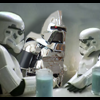
Jonathan's ATA Build[*ATA]
RogueTrooper replied to SirDenzington89's topic in Build Threads Requireing Maintenance
I am glad you started a new post for the fruits of your labor man. Even though you moved it, The bucket still looks great! I am re -posting the paint info so you will not have to jump back to your original post to get it Keep up the GREAT WORK!!! Paint tips: There are some things you will need to do when prepping your helmet for paint. Use a scotchbrite pad on the surface of the helmet first. Then use Simple Green All-Purpose Cleaner or any good All-Purpose Cleaner and then rinse well with water. Then use a lint free cloth with isopropyl alcohol (rubbing alcohol) wipe the surface down to clean any remaining oils and dirt off the surface. Just before you paint, use a tack cloth to remove any dust or loose materials. When you are ready to paint the helmet: Set the helmet on a stand ( use a 2x2 inch think 4ft tall piece of wood, nailed to the center of a 2ft x 2ft piece of plywood for a stable base) the stand is so you can prime and paint all areas without having to touch the helmet. Test your spray paint. Shake the can vigorously before spraying. Test your paint or spraying technique in an inconspicuous area or on a piece of scrap material before beginning to spay your lid. Apply multiple thin coats. Once you have completed your paint test and are satisfied, spray the helmet using several thin, multiple coats instead of one thick coat. Begin and finish your spray pattern off the object, releasing the button at the end of each pass. Use an even side-to-side motion with each pass overlapping your spray pattern. Clean spray valve after use. Before storing your aerosol cans for future use, clean the spray valve by turning the cans upside down and spraying for 5 seconds. This helps prevent the spray tip from clogging. Allow the helmet to dry. Check the directions on the back of the can for a recoat window. A recoat window identifies when additional coats can be applied within a certain timeframe. When you are finished applying all coats, do not handle the helmets surface until the paint has cured. Curing time will vary depending on humidity and temperature. SO do not rush it! You do not want finger prints all over your stormie. Set it somewhere out of the way in a dry, warm place. DO NOT set near a heater, fire place, stove or oven. Type of paint I would suggest is Rust-Oleum aerosol paint (Professional HIGH PERFORMANCE ENAMEL SPRAY- Gloss White 7592) Hope this info help you. If you have any questions dont hesitate to ask! -

Newbie's New Armor!
RogueTrooper replied to SirDenzington89's topic in Hard Armor (General Discussion)
Paint tips: There are some things you will need to do when prepping your helmet for paint. Use a scotchbrite pad on the surface of the helmet first. Then use Simple Green All-Purpose Cleaner or any good All-Purpose Cleaner and then rinse well with water. Then use a lint free cloth with isopropyl alcohol (rubbing alcohol) wipe the surface down to clean any remaining oils and dirt off the surface. Just before you paint, use a tack cloth to remove any dust or loose materials. When you are ready to paint the helmet: Set the helmet on a stand ( use a 2x2 inch think 4ft tall piece of wood, nailed to the center of a 2ft x 2ft piece of plywood for a stable base) the stand is so you can prime and paint all areas without having to touch the helmet. Test your spray paint. Shake the can vigorously before spraying. Test your paint or spraying technique in an inconspicuous area or on a piece of scrap material before beginning to spay your lid. Apply multiple thin coats. Once you have completed your paint test and are satisfied, spray the helmet using several thin, multiple coats instead of one thick coat. Begin and finish your spray pattern off the object, releasing the button at the end of each pass. Use an even side-to-side motion with each pass overlapping your spray pattern. Clean spray valve after use. Before storing your aerosol cans for future use, clean the spray valve by turning the cans upside down and spraying for 5 seconds. This helps prevent the spray tip from clogging. Allow the helmet to dry. Check the directions on the back of the can for a recoat window. A recoat window identifies when additional coats can be applied within a certain timeframe. When you are finished applying all coats, do not handle the helmets surface until the paint has cured. Curing time will vary depending on humidity and temperature. SO do not rush it! You do not want finger prints all over your stormie. Set it somewhere out of the way in a dry, warm place. DO NOT set near a heater, fire place, stove or oven. Type of paint I would suggest is Rust-Oleum aerosol paint (Professional HIGH PERFORMANCE ENAMEL SPRAY- Gloss White 7592) Hope this info help you. If you have any questions don’t hesitate to ask! -

Aliphatic Urethane gloss enamal
RogueTrooper replied to MightyTank's topic in Assembly, Mods, and Painting
Devoe is well known for their expoxy and urethane paints that are used for floors for garages and buildings that have concrete slab floors. Here are some pix to give you an idea what Devoe's products are normally used for. The pix show the accent color material. My suggestion would be to stick with the normal enamel paints like Rustoleum and Krylon style. If you do have access to a spray gun, air compress and booth, then you can go to any pro paint shop and buy it in whatever size you want (pint, quart, gallon, etc.) But you can get excellent results from spray cans, if you take your time. If you are going to do the "devthane 379" then I highly suggest trying it on some scrap, before putting it on you TE2, because it sounds like it may have a urethan base to it and may have a chemical reaction to the HIPS. I don't know if you have painted before, but here are some helpful painting instructions and tips that I posted on the FISD earlier. It is helpful when it comes to painting HIPS or in general any type of paint job. To quote Master Yoda "Do or do not, there is no try". It is possible for a beginner to accomplish a skillful paint job. Let me give you some tips. Preparation is always paramount when it comes to painting. If you do get an ATA kit or any other kit that the armor is made of HIPS, don't try painting the parts before you have assembled your kit. Most glues do not adhere well to painted surfaces. So, once your kit is assembled and all is test fitted for you the way you want it to look, then follow these simple steps: 1.Lightly go over the surface of the suit with a Scotch Brite or Dooby style pad. 2.Clean the surface of your suit with a mild detergent and rinse well. This will help to remove anything from the HIPS that could compromise the paint job like oil from your fingers, and dirt. As an added step, use isopropyl alcohol 70% not 90% (like what you would find in a local drug store). 3.Once you have cleaned the surface and it is dry, go over it with a tack cloth to remove any dust or debris(available at hardware and home improvement stores). 4. Do not paint inside your house. The aerosol fumes are extremely toxic. Work in a well ventilated area, wear a dust/paint mask. Use a drop cloth or newspaper to help keep the area clean. If you do have to paint outside (like most do)then make sure you are not working underneath trees, work in an open area. Also make sure you are not near anyones vehicle because the overspray might blow on to it. 5. Anytime you are painting, the weather will affect the outcome of the paint job. Don't work in too hot or too cold temperatures. This will affect the way the paint flows. Also, humidity and rain will affect it, as well. Read the directions on the aerosol paint can and see what the manufacturers recommended parameters are to achieve the best results. 6. I always believe in priming the surface first with a good primer. This will help the paint to adhere to the HIPS better and help you spot any debris or problems with the surface before you start coating it with the gloss paint. If you do see any problems after priming, it is easier to fix before you spray with gloss paint. When it comes to aerosol primer, there are usually four basic colors: light grey, rust tone, dark grey and white. If you can get the white primer, that would be my first choice, since you are painting in white. To find white aerosol primer, you will have to go to a pro paintshop. But you can use the light grey primer. It will take a few more coats of the white gloss to cover the grey primer, but the grey is easier to find in most stores. 7. Once the primer is dry, and you are ready to start applying your gloss coat, before spraying any gloss, go over the surfaces with a tack cloth (to remove any dust or debris). Now you are ready to start spraying the gloss coat. 8.When painting or priming, always spray light, even, strokes, doing it is stages of several coats. This will help prevent any runs, overspray or splotchy looking paint. Read the directions on the paint can for the "do's and don'ts". If you do have any debris, runs, orange peel, do not try to correct until the paint has completely dried. Messing with it while the paint is wet will only make it worse. You can sand out and fix any small areas and re-paint them. 9.Once you have achieved a good even paint job, let the paint cure. Paint may look and feel dry, but it is still soft. Messing with an uncured paint job may result in getting blemishes, dents and fingerprints in the finished surface. So just set it indoors somewhere warm and safe. Do not set near any heaters, stoves, fireplaces, etc. The soft paint may need to cure for at least a week, maybe longer, depending on the temperature and humidity. A little tip; take a scrap piece of the HIPS and paint it in the same stages as you painted your suit. When you want to check and see if the paint has cured, you can test the scrap piece and not have to mess with your armor. 10.Once the paint has cured and if you see any blemishes such as dust, debris, rough areas, etc.you can wet sand the paint. Wet sanding is a process of using fine grit sandpaper with warm water. The type of sandpaper that you need is the kind that they use for automotive paint jobs (600 up to 2,000 grit). Do not use the regular sandpaper that you would use for wood, it is too harsh and leaves deep sanding marks in gloss paint. The process of wet sanding: Take the sandpaper and dip it into a container of clean warm water. Also slightly wet the painted surface you are working on. Using even pressure, go over the painted surface to take out any debris, dust, orange peel, etc. You will notice after a point, a murkiness to the water on the surface of what you are wet sanding and also on the sandpaper. Dip the sandpaper into the clean water and rinse the surface that you are wet sanding to remove this murkiness. Repeat this step often, changing the water periodically. The cleaner you can keep the surface and sandpaper, the better the results. 11. Once you have wet sanded the surface and achieved a clean even level to the paint job, you will then notice a dullness to the finish. To bring the glossy look back to the finish, there are different rubbing compounds that you can purchase at most automotive parts stores. The rubbing compounds are numbered. The number level indicates the level of the abraisivness of the rubbing compound. Usually the higher the number, the finer the rubbing compound. By working your way up to the finer level compound, you will achieve a higher gloss to the finish. Once you have returned the paint to a glossy surface, you can protect the finish by using a UV protected car wax. The car wax will not only give a lustre, but it will also help protect the paint from becoming faded/yellowed. A major tip: Always do test before painting the suit. My suggestion, if you have not done a lot of painting, is to do test to get familiar with the process. Purchase a few of the plastic "For Sale" signs that you can find at hardware and home improvement stores. The plastic "For Sale" signs are made from HIPS and you will get a sense of how the priming and painting will go. All I can say is don't sweat it if you make any mistakes. That is part of the process of learning. If you do have questions, just ask. Whatever kit that you decide on, whether it is made of HIPS or ABS, just take your time and enjoy the project. This is not a sprint, it is a marathon. -
To quote Master Yoda "Do or do not, there is no try". It is possible for a beginner to accomplish a skillful paint job. Let me give you some tips. Preparation is always paramount when it comes to painting. If you do get an ATA kit or any other kit that the armor is made of HIPS, don't try painting the parts before you have assembled your kit. Most glues do not adhere well to painted surfaces. So, once your kit is assembled and all is test fitted for you the way you want it to look, then follow these simple steps: 1.Lightly go over the surface of the suit with a Scotch Brite or Dooby style pad. 2.Clean the surface of your suit with a mild detergent and rinse well. This will help to remove anything from the HIPS that could compromise the paint job like oil from your fingers, and dirt. As an added step, use isopropyl alcohol 70% not 90% (like what you would find in a local drug store). 3.Once you have cleaned the surface and it is dry, go over it with a tack cloth to remove any dust or debris(available at hardware and home improvement stores). 4. Do not paint inside your house. The aerosol fumes are extremely toxic. Work in a well ventilated area, wear a dust/paint mask. Use a drop cloth or newspaper to help keep the area clean. If you do have to paint outside (like most do)then make sure you are not working underneath trees, work in an open area. Also make sure you are not near anyones vehicle because the overspray might blow on to it. 5. Anytime you are painting, the weather will affect the outcome of the paint job. Don't work in too hot or too cold temperatures. This will affect the way the paint flows. Also, humidity and rain will affect it, as well. Read the directions on the aerosol paint can and see what the manufacturers recommended parameters are to achieve the best results. 6. I always believe in priming the surface first with a good primer. This will help the paint to adhere to the HIPS better and help you spot any debris or problems with the surface before you start coating it with the gloss paint. If you do see any problems after priming, it is easier to fix before you spray with gloss paint. When it comes to aerosol primer, there are usually four basic colors: light grey, rust tone, dark grey and white. If you can get the white primer, that would be my first choice, since you are painting in white. To find white aerosol primer, you will have to go to a pro paintshop. But you can use the light grey primer. It will take a few more coats of the white gloss to cover the grey primer, but the grey is easier to find in most stores. 7. Once the primer is dry, and you are ready to start applying your gloss coat, before spraying any gloss, go over the surfaces with a tack cloth (to remove any dust or debris). Now you are ready to start spraying the gloss coat. 8.When painting or priming, always spray light, even, strokes, doing it is stages of several coats. This will help prevent any runs, overspray or splotchy looking paint. Read the directions on the paint can for the "do's and don'ts". If you do have any debris, runs, orange peel, do not try to correct until the paint has completely dried. Messing with it while the paint is wet will only make it worse. You can sand out and fix any small areas and re-paint them. 9.Once you have achieved a good even paint job, let the paint cure. Paint may look and feel dry, but it is still soft. Messing with an uncured paint job may result in getting blemishes, dents and fingerprints in the finished surface. So just set it indoors somewhere warm and safe. Do not set near any heaters, stoves, fireplaces, etc. The soft paint may need to cure for at least a week, maybe longer, depending on the temperature and humidity. A little tip; take a scrap piece of the HIPS and paint it in the same stages as you painted your suit. When you want to check and see if the paint has cured, you can test the scrap piece and not have to mess with your armor. 10.Once the paint has cured and if you see any blemishes such as dust, debris, rough areas, etc.you can wet sand the paint. Wet sanding is a process of using fine grit sandpaper with warm water. The type of sandpaper that you need is the kind that they use for automotive paint jobs (600 up to 2,000 grit). Do not use the regular sandpaper that you would use for wood, it is too harsh and leaves deep sanding marks in gloss paint. The process of wet sanding: Take the sandpaper and dip it into a container of clean warm water. Also slightly wet the painted surface you are working on. Using even pressure, go over the painted surface to take out any debris, dust, orange peel, etc. You will notice after a point, a murkiness to the water on the surface of what you are wet sanding and also on the sandpaper. Dip the sandpaper into the clean water and rinse the surface that you are wet sanding to remove this murkiness. Repeat this step often, changing the water periodically. The cleaner you can keep the surface and sandpaper, the better the results. 11. Once you have wet sanded the surface and achieved a clean even level to the paint job, you will then notice a dullness to the finish. To bring the glossy look back to the finish, there are different rubbing compounds that you can purchase at most automotive parts stores. The rubbing compounds are numbered. The number level indicates the level of the abraisivness of the rubbing compound. Usually the higher the number, the finer the rubbing compound. By working your way up to the finer level compound, you will achieve a higher gloss to the finish. Once you have returned the paint to a glossy surface, you can protect the finish by using a UV protected car wax. The car wax will not only give a lustre, but it will also help protect the paint from becoming faded/yellowed. A major tip: Always do test before painting the suit. My suggestion, if you have not done a lot of painting, is to do test to get familiar with the process. Purchase a few of the plastic "For Sale" signs that you can find at hardware and home improvement stores. The plastic "For Sale" signs are made from HIPS and you will get a sense of how the priming and painting will go. All I can say is don't sweat it if you make any mistakes. That is part of the process of learning. If you do have questions, just ask. Whatever kit that you decide on, whether it is made of HIPS or ABS, just take your time and enjoy the project. This is not a sprint, it is a marathon.
-
My boots, my boots, my boots are OK! I just dyed mines too. I used a shoe dye & auto-shine product. It came with a prepare product that smelled like isopropyl alcohol, so I'm not shure if the dye is going to stay there for long. If it starts to peel I'll buy some acetone and dye them again. When finished I applied a white shine foam I bought at a supermarket. Here's the end result: ---------- It's not as white as I'd like, but it's pretty decent. I still have to clean the sole of the boot on the back.
-
I use the Novus for both fine scratches as well as overall polishing. For scuff marks, i use rubbing (isopropyl) alcohol. Some guys use lighter fluid for stubborn marks. Not sure about removing glue, though.
-
I could be wrong but I think some of the newer anti-fog products are isopropyl alcohol and a light wax, I'd have to check to be %100 though.



